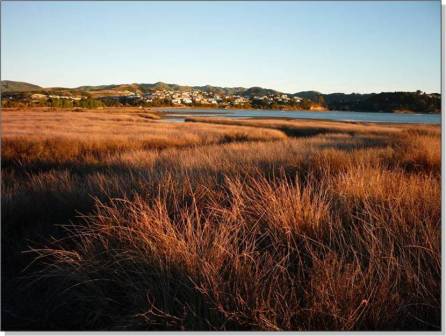Saltmarsh
A saltmarsh is a type of wetland that occupies the intertidal zone between land and sea. It is an area of low level, flat, poorly drained ground subject to regular tidal flooding by salt or brackish water. Saltmarshes are common along low sea coasts, inside barrier bars and beaches, in estuaries and on deltas.
The plant communities found in saltmarsh habitats are dominated by rushes and sedges. These plants are specialised for living in various concentrations of salinity and various periods of submersion. They are called halophytes and as well as the rushes, there are glasswort and sea primrose, found at the low tide zone, withstanding the longest periods of submersion.
Marshes and wetlands everywhere used to be thought of as wasteland that could be filled in to provide land for agriculture or industrial development. Fortunately, they are no longer seen as unimportant – in fact they are now recognized as one of the most biologically productive habitats on the planet. In some parts of the world (on the southeast coast of the USA, for example) the organic detritus resulting from the decay of cast-off leaves of saltmarsh plants provides enough food for creatures at the base of food chains to support and sustain major inshore fisheries.

The importance of saltmarsh
The importance of the Pāuatahanui Inlet saltmarsh with its associated wetland bird population was recognized, and its protection assured, with the designation of the Pāuatahanui Inlet Wildlife Reserve in the 1980s.
-
-
- It traps sediment that is washed into the Inlet by streams and stormwater drains. While this natural reclamation process slowly advances the marsh into the Inlet it slows down the sedimentation of the main body of the Inlet.
- It reduces erosion of the seabed and of the shoreline by wave action.
- It absorbs excess nutrients from both the fresh water and sea water that enters the marsh. This reduces eutrophication and the excessive growth of undesirable species of algae.
- It slowly transfers nutrients from the sediment to the water, enabling the growth of phytoplankton, an important food source for filter-feeding animals in the Inlet.
- It produces most of the food required by the Inlet’s herbivores and detritus-feeders at the start of the food chain.
- It provides shelter, breeding sites and food for wildlife.
- The viability of the Inlet depends to a large extent on the continued presence of a sizeable salt marsh area.
-
See the range of plants that grow in the saltmarshes.
Read a detailed description of the rushes of Pāuatahanui Inlet.